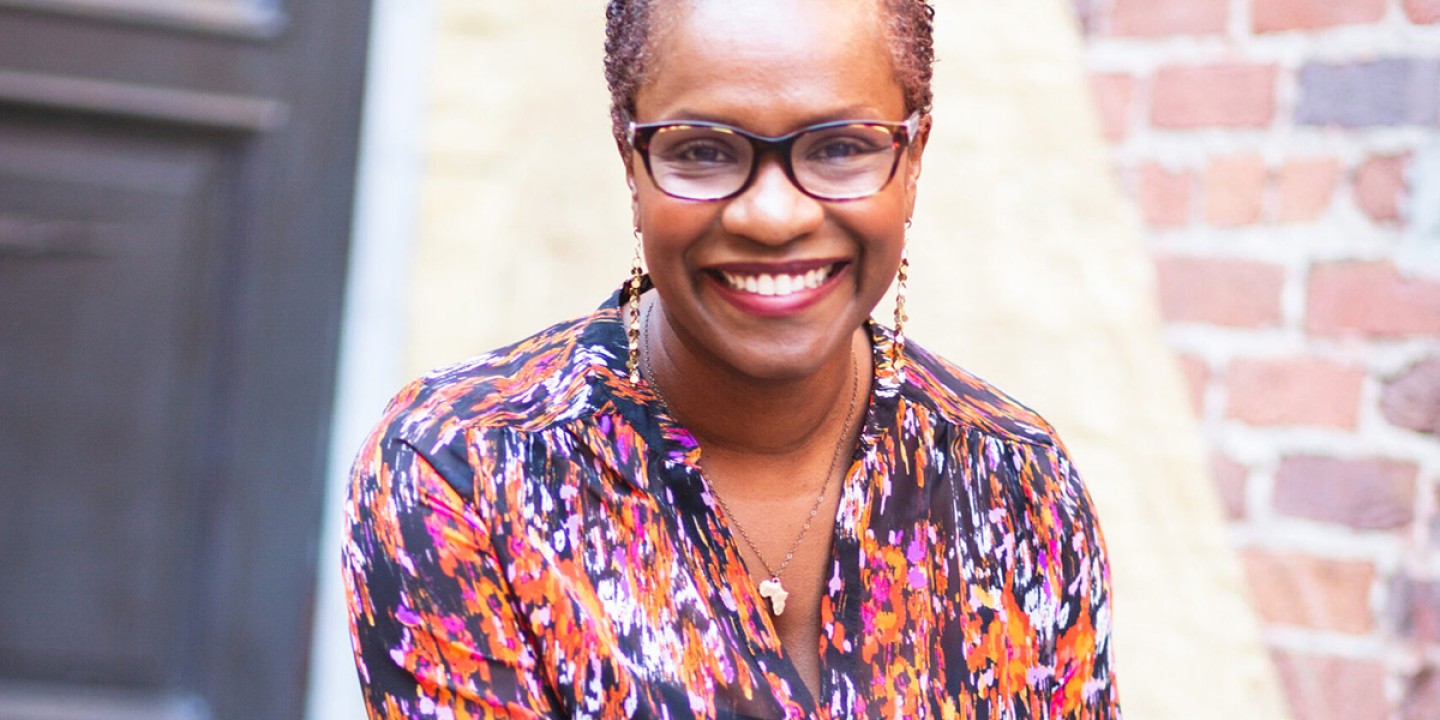The beauty of representation in children’s books
“I was a child who loved to read. But I didn’t see a lot of characters that looked like me.”

Dorena Williamson is the cofounder and first lady of Strong Tower Bible Church in Nashville and a best-selling author of children’s books. The Celebration Place, which describes the beauty of multicultural and intergenerational worship, will be published next month by IVP Kids. Crowned with Glory, a celebration of a Black girl and her beautiful hair, will be published by WaterBrook in January.
How did you start writing children’s books? Is it something you ever imagined as a child?
I was a child who loved to read, but I never imagined I’d write books for children. I loved to sit with difficult stories, like A Little Princess by Frances Hodgson Burnett. Sara Crewe was one of my favorite characters. But I didn’t see a lot of characters that looked like me. I want to give to the next generation the beauty, love, inspiration, and imagination that I found in books—but also more representation.
Read our latest issue or browse back issues.
Writing children’s literature has been a delightful midlife adventure. It was a segue out of my journaling about the things I saw happening: the continued loss of beautiful Black life at the hands of police, but also things like Mattel expanding its Barbie doll lines to include deeper skin tones. A lot of people were responding to the brokenness in our culture by saying, “I teach my kids not to see race.” Because I knew this was neither true nor helpful, I felt inspired to speak to the narrative of colorblindness. As I began assembling these thoughts into what I thought would be a blog post, I realized it could be a children’s book.
I imagine writing children’s books is a lot more difficult than most of us assume it to be. Is it limiting at times to write in this genre?
I’ve only published children’s books so far, but as of right now, it is definitely my love and my happy place. One of the things I find both difficult and a welcome challenge is taking concepts that we talk about all the time, like racism and injustice, and figuring out how to break them down in a way that children can grasp them. It is so much more difficult than people think. When you take a concept and start to try to break it down, suddenly 250 words feels impossibly small.
I find a lot of inspiration in the way Jesus communicated, using things that were relevant to his audience. We may not be thinking about mustard seeds in our day-to-day Western lives, but to a first-century Eastern culture, that was relevant. Jesus was able to break things down. Still, his disciples would sometimes say, “OK, master, we don’t understand what you’re saying.” I find that really encouraging.
Your website says, “I write children’s books that adults need too.” Why do you find that adults also need children’s literature?
We tell the big people—the parents, aunties and uncles, neighbors, and teachers—that they need to do the important work of imparting values to children. But so many adults didn’t grow up with those conversations, and they’re not something that people can just naturally enter into with the care and intentionality they require. We need to be taught, but we also need our biases to be challenged. We need all the junky things that are in our hearts, all the unhealthy values that were passed down to us, to be confronted so that we don’t pass them down to our children. After I released my first book, ColorFull, parents and children's ministry leaders said to me, “I didn’t talk about things like this growing up! I appreciate what you’re writing because I need tools to help me.”
Grandparents are constantly on my mind too, because they so often read books with their grandchildren. When they’re reading GraceFull and see the homeless family, children might ask their grandparents questions. The grandparents might then realize: My life doesn’t intersect with people who are walking with homelessness, and my grandchildren are unpacking this truth. I need to do some work myself. I see such beauty and power in generations learning together.
ColorFull provides an alternative to the rhetoric of colorblindness. It also encourages kids to embrace creation. Tell us about how you made that connection—that color applies not just to discussions of race but also to seeing the physical world and other people as God’s creation.
It’s foundational for kids to learn their colors. When my oldest was learning to speak and he said cows were purple, I knew I had work to do. ColorFull unpacks why it’s not helpful to approach race with a colorblind approach, using a parallel that is easy for people to get. When you’re helping your kids pick out what they want to wear and they choose a red boot, a brown boot, and a green shirt, you never tell them that colors don’t matter because we’re colorblind. Instead, you praise their creativity. As children learn to celebrate the colors around them, we encourage that curiosity and awareness. We see it as a gift.
Just as we encourage our kids to celebrate all of the colors in this world as a gift that God has given us, let’s teach them to celebrate and see the beauty of all our diverse skin colors.
How did The Celebration Place come to be? Was there a particular theological message you wanted to make accessible to kids?
The Celebration Place was inspired by the beautiful church community that I get to experience every week, which my husband and I planted here in Tennessee. It’s a multiethnic congregation where we worship God by honoring our differences and celebrating one another.
This book shows children that church is a place where we celebrate who God is but we also get to celebrate one another. There are so many diverse and beautiful expressions of worship pictured in the book, showing that this is God’s heart. Jesus’ sacrifice made this celebration possible, and the Holy Spirit’s power is what brings us together. Unity in the midst of diversity is not about whitewashing away all of those beautiful things that make us different from one another; it’s about coming together and celebrating them.
One thing that stands out to me in The Celebration Place is its inclusion of not just diverse races and cultures, but also diverse abilities. Can you speak to the role of disability in church?
Many churches have done the good work of ensuring that their buildings are accessible to people whatever their physical needs may be. But to be truly welcoming—in a way that goes beyond just saying “we want you to be here” in our signage and on our websites—we need to work from a staffing and volunteering perspective to ensure that every family is supported. We should be gathering those who are sometimes placed last or on the margins and saying to them, “We reserve the best place for you.” I salute children’s ministry leaders who intentionally ask all families, “Are we serving the needs of your children?” and then follow through in both word and deed.
Diversity was clearly at the front of your mind when you were writing this book. When you collaborate with an illustrator, how specific are you in asking for things like diversity?
A lot of that begins with the editor. When they secure a partnership with the illustrator for the project, they communicate my heart. There are illustrator notes in the manuscript, so the illustrator knows what we’re envisioning in each spread. But I love it when illustrators take liberty. I don’t prescribe every detail about everything on a page, although in general there is a vision for each spread. As each spread is developed, my editor will send it back to me to ask for my input on how it looks—including small details, like whether I like the color of the clothes on the children. It’s very collaborative and fun. The end result, I feel, captures the heart behind the words that I wrote.
One of my favorite spreads in The Celebration Place is a beautiful illustration of Indigenous dancers. How did you decide to include Indigenous religious traditions in this book?
That spread is dear to my heart because it is part of our church experience. We have some Native American families who are dear friends. Learning from them has been such an amazing journey for me as a Black woman who came to realize that I was ignorant of the beauty and pain of Indigenous history. When these friends invited us to worship at Strong Tower Bible Church in their way, with their language and music, it was beautiful. They worship God as Creator, so it was a moment of worshiping the same God together—but expressed in a way that most people had never seen in church.
I sent the illustrator a picture that I took of my Native American friends dancing in our church and said I wanted the spread to be directly inspired by this picture. When I later sent my friends the spread, they absolutely loved it and were honored by it.
I’m really interested in your forthcoming book Crown of Glory. Several books about Black hair have come out recently. Why is it important to make the connection between God, Black hair, and Black beauty?
I love being able to add an element of my faith to it, to say, “I am crowned with God’s glory because that’s how he made me.” That’s inspired by Psalm 8. As I read those words, I thought about how hair is often considered a crown, which is also a biblical term. I incorporated scenes from my experiences and my daughters’ experiences, showing the struggle to feel confident in your skin and know that you are a beautiful creation crowned with God’s glory.
When children look at this book, they’ll see it as a mirror if they are brown like me and they see themselves in this girl. Or they’ll see it as a window: they’ll see this little girl and think, She doesn’t look like me, but she reminds me that I am crowned with God’s glory.
Do you see a change in what children’s literature looks like today compared to when you were little?
I definitely see a change, and it’s beautiful. When I was growing up in the 1970s, children’s literature was mostly shaped with White faces on the cover, so I had to lean into my imagination and find those select few that weren’t. It’s so inspiring to see that today there are myriad opportunities to learn and grow. For example, now we have publishing lines focused on cultivating Indigenous stories, so that children can learn not only from authors who feature Indigenous characters but also from Indigenous authors who have a platform to share their own stories.
What’s next for you?
I have some things in the works that will continue what I believe is my calling: giving diverse ethnic representation in stories that warm the heart, inspire the mind, and encourage children. They will still be based in my Christian faith but with universal values that I believe all people will be able to enjoy.
This is holy and precious work, because children are our treasure. When Jesus said, “If you want to be great, you need to humble yourself and be like a child,” he was centering children, saying they are the greatest. So, I get to write for the greatest! Children have such a great opportunity to be part of growing our world in healthy ways, doing the good work of justice and righteousness. If the little kids can do the work, then there’s hope for the rest of us.
A version of this article appears in the print edition under the title “Joyful representation.”





